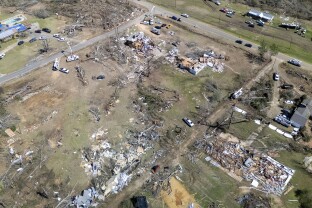The National Weather Service is dramatically scaling back weather balloon launches across the country, cutting a critical source of data for extreme weather forecasting due to staffing shortages.
Balloons will no longer be launched in Omaha, Nebraska, and Rapid City, South Dakota, and twice-daily launches will be cut to once per day for other regional offices scattered throughout Nebraska, South Dakota, Colorado, Michigan and Wyoming, the NWS announced Thursday. Staffing issues have plagued regional weather offices since the Trump administration began layoffs and buyouts, and Thursday’s announcement cited personnel shortages as the reason for the indefinite suspension in balloon launches.
Meteorologists immediately warned that such dramatic cuts could affect the accuracy of weather forecasting models, which are fed data from twice-daily weather balloon launches into the atmosphere that usually occur at 100 sites across the country and in US territories. Data from these balloons is even more important in the event of extreme weather, experts said.
“The loss of this data is potentially very damaging to forecast accuracy,” said Chris Vagasky, a meteorologist who spent much of his career working for one of the few companies that makes the technology used in weather balloons. “What we want as meteorologists is to give people as much time to start making plans for what they’re going to do in case of hazardous weather. And if we are struggling to pinpoint exactly where the severe weather is going to be, because we’re missing data, our forecast may be off.”
The cuts announced Thursday were by far the largest to come at once, building upon already announced cuts in Alaska, New York and Maine.
“There are likely more to come, too,” Kelton Halbert, a meteorologist at the NWS Storm Prediction Center, said on social media about the weather balloon cuts.
Other experts said the public might not feel the effects of the cuts right away but they would have an impact on accurate forecasting.
“It’s not unlikely that if the situation continues, already this summer our capacity to predict risks and to predict adverse weather events could be impacted,” said Daniele Visioni, an atmospheric science researcher at Cornell University. “It’s complicated in the sense that people will not feel an immediate impact;, NWS is going to keep working. It’s more going to be a slow degradation of our ability to predict weather and to predict risk.”
Because the balloon launch cuts were mostly in northern parts of the country, much of the data will be missing in areas connected to each other — from Colorado to Maine. The Plains and Upper Midwest states are entering tornado season and have already seen the kinds of extreme weather events where the balloon data can be useful. Deadly storms earlier this week killed at least 40 people and spawned nearly 90 tornadoes.
“Our modelling is so good these days because we have good data that’s feeding it,” Vagasky said. “As soon as we start losing what we have, that negatively impacts the forecast that we’re able to provide.”
—
Anna Kramer is a reporter at NOTUS.
Sign in
Log into your free account with your email. Don’t have one?
Check your email for a one-time code.
We sent a 4-digit code to . Enter the pin to confirm your account.
New code will be available in 1:00
Let’s try this again.
We encountered an error with the passcode sent to . Please reenter your email.


